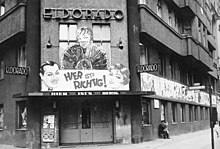Nollendorfkiez

The Nollendorfkiez (also called Fuggerkiez or Motzstraßenkiez ) is a residential area in the Berlin district of Schöneberg in the Tempelhof-Schöneberg district . The name of the Nollendorfkiez does not represent an administrative unit and therefore has no clearly defined boundaries. In general, the Kiez encompasses the area from the eponymous Nollendorfplatz with the Motzstraße that branches off to Viktoria-Luise-Platz and the branch roads and nearby side streets to Kleiststraße in the north and Hohenstaufenstraße in the south.
The area has a high proportion of historical buildings from the time before the First World War . Due to the proximity to the New West and the General Train , the buildings were mostly designed for upscale living, with large apartments and representative stairwells.
history

Since the 1920s at the latest, a lesbian and gay district has been able to establish itself here , a district with an infrastructure specially designed for queer people. In the 1920s, this scene extended spatially well beyond what is now the district, from Dennewitzplatz via Bülowstrasse to Augsburger Strasse . Important addresses were the Eldorado , the Nationalhof , the Toppkeller , the Dorian Gray , the Kleist Casino as well as the Hohenzollern-Diele and the Mali and Igel . An early literary testimony to this time, is the autobiographical novel Goodbye To Berlin by Christopher Isherwood , who in 1929 lived 17-1933 in Nollendorfstrasse and worked until he was forced as a result of the " seizure of power " Hitler to leave Berlin. The novel served, among other things, as a template for the musical Cabaret .

A plaque at the entrance to the Nollendorfplatz underground station commemorates the persecution and murder of homosexuals during the Nazi dictatorship .
The Second World War and the Nazi regime ended queer visibility in the Nollendorfkiez. After the Second World War, the quarter recovered only very slowly, but some restaurants such as the Nationalhof (as Walterchens Ballhaus) or the Kleist Casino were retained or newly established. It was only with the second lesbian and gay movement in the 1970s that the quarter revived as a gay and lesbian neighborhood.
A few years later, Romy Haag opened the Cabaret Chez Romy in the rooms of the former Eldorado on Motzstraße, based on the cabarets of the interwar years. The Chez Romy remained a popular meeting place for Berlin artists for many years. Among other things, David Bowie , who had a relationship with Haag during these years, stayed there.
The lesbian-gay street festival has been taking place every year on Motzstraße since 1993 . For queer people there are again numerous offers in the neighborhood ; Bars and pubs, bed and breakfasts, medical practices as well as advice centers and the office of the LSVD Berlin-Brandenburg .
Attractions
New playhouse
The New Playhouse is a theater building from 1906. With its lavish furnishings, the rich bourgeoisie from the New West and the Kaiserhof from the historical center were specifically intended to lure into the Nollendorfplatz quarter. From 1912 the theater hall was also used as a cinema, and numerous UFA premieres took place here in the 1920s . The building survived the Second World War largely unscathed and was used exclusively as a cinema until 1977. It then served as a disco and event location with changing operators, including under the name Goya. It was closed in 2014 and reopened as Metropol in 2019 .
St. Matthias Church
The parish church of St. Matthias is a Catholic church building on Winterfeldtplatz . The building was completed in 1885 as the main Catholic church in Schöneberg, which at that time was still a suburb of the imperial city of Berlin. The church burned down in the Second World War, but was restored in the following years with a simplified interior and a shortened tower. During the division of Germany , due to its size and central location, it served as a cathedral church for official services and funerals in West Berlin .
Prominent residents
- Clemens August Graf von Galen , pastor of St. Matthias Church on Winterfeldplatz from 1919 to 1929 , later became known as the Lion of Münster because of his energetic opposition to the euthanasia programs of the National Socialists
- Christopher Isherwood , writer, lived at Nollendorfstrasse 17 from 1929–1933
- Otto Klemperer , conductor, composer and opera director lived at Maaßenstraße 35 from 1930 until he emigrated to the USA in 1933
- Else Lasker-Schüler , writer and poet, lived at Motzstrasse 7 from 1924–1933
- Nelly Sachs , writer and winner of the Nobel Prize for Literature , was born at Maaßenstrasse 12
- Claire Waldoff , cabaret artist and actress, lived at Regensburger Strasse 33 from 1919 to 1933
- Billy Wilder , director and screenwriter, lived at Viktoria-Luise-Platz 11 from 1927–1928
- Käthe Reinhardt , a lesbian activist, lived in Motzstrasse in 1935 and on Winterfeldtstrasse from 1951 to the 1970s
Individual evidence
- ↑ Nollendorfplatz - The Nollendorfkiez is our home . In: Nollendorfkiez ... we are Kiez . ( nollendorfkiez.de [accessed on March 24, 2017]).
Coordinates: 52 ° 29 ′ 51 ″ N , 13 ° 20 ′ 58.6 ″ E